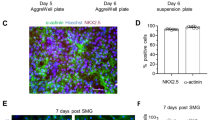Summary
Although a wealth of evidence supports the hypothesis that some functions of the nervous system may be altered during exposure to microgravity, the possible changes in basic neuronal physiology are not easy to assess. Indeed, few studies have examined whether microgravity affects the development of neurons in culture. In the present study, a suspension of dissociated cortical cells from rat embryos were exposed to 24 h of simulated microgravity before plating in a normal adherent culture system. Both preexposed and control cells were used after a period of 7–10 d in vitro. The vitality and the level of reactive oxygen species of cultures previously exposed did not differ from those of normal cultures. Cellular characterization by immunostaining with a specific antibody displayed normal neuronal phenotype in control cells, whereas pretreatment in simulated microgravity revealed an increase of glial fibrillary acidic protein fluorescence in the elongated stellate glial cells. Electrophysiological recording indicated that the electrical properties of neurons preexposed were comparable with those of controls. Overall, our results indicate that a short time of simulated microgravity preexposure does not affect dramatically the ability of dissociated neural cells to develop and differentiate in an adherent culture system.
Similar content being viewed by others
References
Brady, S.; Colman, D. R.; Brophy, P. Subcellular organization of the nervous system: organelles and their functions. In: Zigmond, M. J.; Bloom, F. E.; Landis, S. C.; Roberts, L. J.; Squire, L. R., ed. Fundamental neuroscience. San Diego, CA: Academic Press, 1999:71–106.
Day, J. R.; Frank, A. T.; O'Callaghan, J. P.; DeHart, B. W. Effects of microgravity and bone morphogenetic protein II on GFAP in rat brain. J. Appl. Physiol. 85:716–722; 1998.
Eddleston, M.; Mucke, L. Molecular profile of reactive astrocytes—implications for their role in neurologic disease. Neuroscience 54:15–36; 1993.
Eng, L. F.; Ghirnikar, R. S. GFAP and astrogliosis. Brain Pathol. 4:229–237; 1994.
Freed, L. E.; Pellis, N.; Searby, N.; de Luis, J.; Preda, C.; Bordonaro, J.; Vunjak-Novakovic, G. Microgravity cultivation of cells and tissues. Gravit. Space Biol. Bull. 12(2):57–66; 1999.
Gruener, R. Neuronal responses to vector-averaged gravity: a search for gravisensing and adaptation mechanisms—a preliminary report. Uchu. Koku. Kankyo. Igaku. 35:63–83; 1998.
Gruener, R.; Hoeger, G. Vector-free gravity disrupts synapse formation in cell culture. Am. J. Physiol. 258:C489-C494; 1990.
Gruener, R.; Hoeger, G. Vector-averaged gravity alters myocyte and neuron properties in cell culture. Aviat. Space Environ. Med. 62:1159–1165; 1991.
Honegger, P. Aggregate cell cultures. Altex 6:29–36; 1989.
Honegger, P.; Lenoir, D.; Favrod, P. Growth and differentiation of aggregating fetal brain cells in a serum-free defined medium. Nature 282:305–308; 1979.
Ishihara, A.; Ohira, Y.; Roy, R. R.; Nagaoka, S.; Sekiguchi, C.; Hinds, W. E.; Edgerton, V. R. Effects of 14 days of spaceflight and nine days of recovery on cell body size and succinate dehydrogenase activity of rat dorsal root ganglion neurons. Neuroscience 81:275–279; 1997.
Jessup, J. M.; Pellis, N. R. NASA biotechnology: cell science in microgravity. In Vitro Cell. Dev. Biol. 37A:2; 2001.
Kallos, M. S.; Behie, L. A. Inoculation and growth conditions for high-cell-density expansion of mammalian neural stem cells in suspension bioreactors. Biotechnol. Bioeng. 63:473–483; 1999.
Kimelberg, H. K.; Noremberg, M. D. Astrocytes. Sci. Am. 260:66–76; 1989.
Krasnov, I. B. Gravitational neuromorphology. Adv. Space Biol. Med. 4:85–110; 1994.
Lebel, C. P.; Ishiropoulos, H.; Bondy, S. C. Evaluation of the probe 2′,7′-dichlorofluorescin as an indicator of reactive oxygen species formation and oxidative stress. Chem. Res. Toxicol. 5:227–231; 1992.
Lelkes, P. I.; Galvan, D. L.; Hayman, G. T.; Goodwin, T. J.; Chatman, D. Y.; Cherian, S.; Garcia, R. M.; Unsworth, B. R. Simulated microgravity conditions enhance differentiation of cultured PC12 cells towards the neuroendocrine phenotype. In Vitro Cell. Dev. Biol. 34A:316–325; 1998.
Lewis, M.; Reynolds, J. L.; Cubano, L. A.; Hatton, J. P.; Lawless, B. D.; Piepmeier, E. H. Spaceflight alters microtubules and increases apoptosis in human lymphocytes (Jurkat). FASEB J. 12:1007–1018; 1998.
Maccioni, R. B.; Cambiazo, V. Role of microtubule-associated proteins in the control of microtubule assembly. Physiol. Rev. 75:835–864; 1995.
Miller, J. D.; McMillen, B. A.; McConnaughey, M. M.; Williams, H. L.; Fuller, C. A. Effects of microgravitys on brain neurotransmitter receptors. Eur. J. Pharmacol. 161:165–171; 1989.
Rucci, N.; Migliaccio, S.; Zani, B. M.; Taranta, A.; Teti, A. Characterization of the osteoblast-like cell phenotype under microgravity conditions in the NASA-approved rotating wall vessel bioreactor (RWV). J. Cell Biochem. 85(1):167–179; 2002.
Sen, A.; Kallos, M. S.; Behie, L. A. Expansion of mammalian neural stem cells in bioreactors: effects of power input and medium viscosity. Brain Res. Dev. Brain Res. 134:103–113 2002.
Shafit-Zagardo, B.; Kalcheva, N. Making sense of the multiple MAP-2 transcripts and their role in the neuron. Mol. Neurobiol. 16:149–162; 1998.
Trapp, B. D.; Honegger, P.; Richelson, E.; Webster, H. D. Morphological differentiation of mechanically dissociated fetal rat brain in aggregating cell cultures. Brain Res. 160:117–130; 1979.
Trapp, B. D.; Webster, H. D.; Johnson, D.; Quarles, R. H.; Cohen, S. R.; Murray, M. R. Myelin formation in rotation-mediated aggregating cell cultures: immunocytochemical, electron microscopic, and biochemical observations. J. Neurosci. 2:986–993; 1982.
Unsworth, B. R.; Lelkes, P. I. Growing tissues in microgravity. Nat. Med. 4:901–907; 1998.
Uva, B. M.; Masini, M. A.; Sturla, M.; Prato, P.; Passalacqua, M.; Giuliani, M.; Tagliaferro, G.; Strollo, F. Clinorotation-induced weightlessness influences the cytoskeleton of glial cell in culture. Brain Res. 934:132–139; 2002.
Vasquez, M. E. Neurobiological problems in long-term deep space flights. Adv. Space Res. 22:171–183; 1998.
Wang, H.; Joseph, J. A. Quantifying cellular oxidative stress by dichlorofluorescein assay using microplate reader. Free Radic. Biol. Med. 27:612–616; 1999.
Wang, S. S. S.; Good, T. A. Effect of culture in a rotating wall bioreactor on the physiology of differentiated neuron-like PC12 and SH-SY5Y cells. J. Cell. Biochem. 83:574–584; 2001.
Author information
Authors and Affiliations
Corresponding author
Rights and permissions
About this article
Cite this article
Crestini, A., Zona, C., Sebastiani, P. et al. Effects of simulated microgravity on the development and maturation of dissociated cortical neurons. In Vitro Cell.Dev.Biol.-Animal 40, 159–165 (2004). https://doi.org/10.1290/1543-706X(2004)40<159:EOSMOT>2.0.CO;2
Received:
Accepted:
Issue Date:
DOI: https://doi.org/10.1290/1543-706X(2004)40<159:EOSMOT>2.0.CO;2




